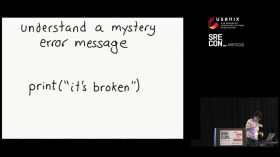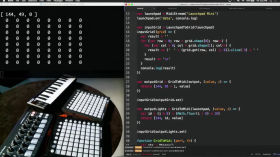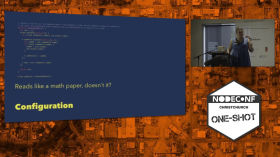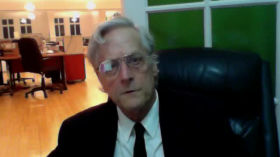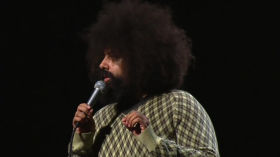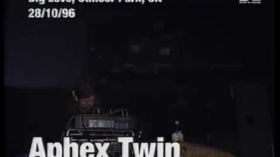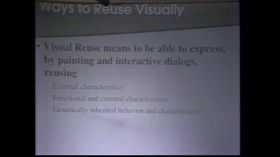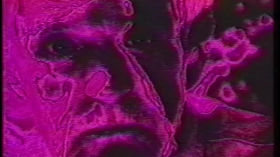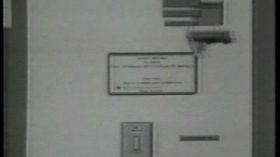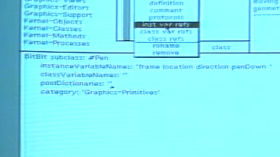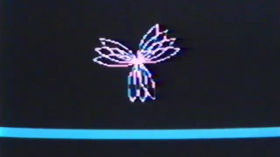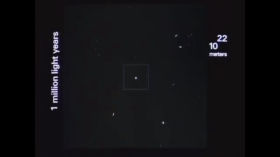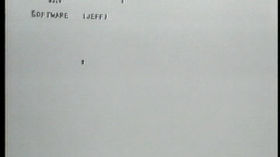A collection of videos to showcase the magic alchemy of computation. ✨
What is computing if you take away all hardware in front of your eyes? 🌱
What does computing mean to humanity? 🌻
- PeerTube: @intertwingled@tube.arthack.nz
- GitHub: ahdinosaur/intertwingled
Not sure where to start?
- (2013) The Future of Programming : Bret Victor
- (1997) The Computer Revolution Hasn't Happened Yet : Alan Kay
See also:
To add or remove a video, see contributing guide.
One of my favorite papers in computer science is the original LISP paper by John McCarthy. Written in 1959, it describes something mind-bending: The interpreter for a language in the language that it interprets. If you understand this paper, you understand how computation works.
Source: https://archive.org/details/lca2019-Lets_LISP_like_its_1959
A 40-minute video compilation of filmclips, photos and videos from the 50 year history of the Whole Earth publications (plus sponsored/hosted events and contributors) created for the 50th anniversary event at the San Francisco Art Institute on 13 October 2018.
Source: https://vimeo.com/294878432/3ff748dd5e
Demonstration and discussion of the programming language and environment "Smalltalk-76” with Dan Ingalls.
Source: https://youtu.be/NqKyHEJe9_w
Source: https://youtu.be/vMlS4NscEvc
Audrey Tang, hacker turned Digital Minister shares stories of the dramatic transformations underway to upgrade internet democracy in Taiwan. Civic hackers are supporting activists, voters and political leaders with a constantly refined set of online tools that allows them to share information, mobilize and participate in decision-making.
Source: https://youtu.be/5DkhUO7LiGs
William E. Byrd "explores what he considers to be the most beautiful program ever written---a Lisp interpreter written in Lisp---and a few of the many amazing ideas related to this metacircular interpreter."
Source: https://youtu.be/OyfBQmvr2Hc
Transcript: https://jvns.ca/blog/so-you-want-to-be-a-wizard/
Source: https://youtu.be/qj2j93L9564
Kurt Gödel showed that mathematical thinking cannot be captured in a formal axiomatic reasoning system. What does this deep result mean in practice? What are the limits of computer thinking? Can beauty and creativity and a sense of humor be formalized?
Source: https://youtu.be/V9ohtKameio
Computer code is the next universal language, and its syntax will be limited only by the imaginations of the next generation of programmers. Linda Liukas is helping to educate problem-solving kids, encouraging them to see computers not as mechanical, boring and complicated but as colorful, expressive machines meant to be tinkered with. In this talk, she invites us to imagine a world where the Ada Lovelaces of tomorrow grow up to be optimistic and brave about technology and use it to create a new world that is wonderful, whimsical and a tiny bit weird.
Source: https://archive.org/details/LindaLiukas_2015X
A JavaScript hacker and backyard musician and from Wellington, NZ. Lover of all things open and modular. I spend most of my time pressing buttons of various shapes, sizes and colours. Sometimes these buttons make sounds.
Source: https://youtu.be/NL0nb8A8FDM
We learn and are taught to write software, and a lot of time and effort and research has been put into how to do this well, to varying degrees of success. We learn to evaluate libraries based on external factors like tests and documentation, but often we skip the most obvious part. How do we read source code?
Source: https://youtu.be/-KgU5sxGtuM
Databases are global, shared, mutable state. That's the way it has been since the 1960s, and no amount of NoSQL has changed that. However, most self-respecting developers have got rid of mutable global variables in their code long ago. So why do we tolerate databases as they are? --- A more promising model, used in some systems, is to think of a database as an always-growing collection of immutable facts. You can query it at some point in time — but that's still old, imperative style thinking. A more fruitful approach is to take the streams of facts as they come in, and functionally process them in real-time.
Source: https://youtu.be/fU9hR3kiOK0
Chris Granger attempts to imagine what programming would look like if it was created today.
Source (with slides): https://www.infoq.com/presentations/reimagining-software/
Douglas Hofstadter attempts to get across the crux of these intuitions about the mysterious concept of "I".
Source: https://www.infoq.com/presentations/strange-loop-keynote/
For references and more information, see http://worrydream.com/dbx/
Source: https://vimeo.com/71278954
In the past decade, we've seen the rise of powerful social networks of unprecedented scale, connecting millions or even billions of people who can now communicate almost instantaneously. But many of the promises that were made by the creators of the earliest social networking technologies have gone unfulfilled. We'll take a look at some of the unexamined costs, both cultural and social, of the way the web has evolved.
Source: https://www.youtube.com/watch?v=9KKMnoTTHJk
How do we -- as individuals and as communities -- make decisions when faced with uncertainty, inexperience, lack of knowledge or chaos? Nassim N. Taleb and Nobel Prize winner Daniel Kahneman have both devoted their careers to explorations of the decision making process: Kahneman approaching it through psychological study; Taleb through a philosophical lens. Their groundbreaking work has profoundly impacted our understanding of the decision making process today while raising new questions about how decisions are made in a world that is increasingly more difficult to comprehend.
Source: https://www.nypl.org/audiovideo/live-nypl-nassim-taleb-daniel-kahneman
A short video about the "Overview Effect" experienced by most astronauts and cosmonauts - the life changing awe of seeing Earth from orbit in space.
Source: https://vimeo.com/55073825 or https://archive.org/details/Overview_201806
Notes: https://github.com/dominictarr/presentations/blob/master/duplo-and-crayons.md
Source: https://youtu.be/OBqZsTX4b_s
Ted Nelson continues to cast doubt on Computer Basics.
Source: https://youtu.be/w950GgRzbJk
Ted Nelson continues to cast doubt on Computer Basics.
Source: https://youtu.be/gWDPhEvKuRY
Ted Nelson continues to cast doubt on Computer Basics.
Source: https://youtu.be/_9PmIkAYhI0
Ted Nelson continues to cast doubt on Computer Basics.
Source: https://youtu.be/_xL19f48m9U
Ted Nelson continues to cast doubt on Computer Basics.
Source: https://youtu.be/bhzD2FKEEds
Ted Nelson continues to cast doubt on Computer Basics.
Source: https://youtu.be/c6SUOeAqOjU
Ted Nelson continues to cast doubt on Computer Basics.
Source: https://youtu.be/Qfai5reVrck
Ted Nelson casts doubt on Computer Basics.
Source: https://youtu.be/KdnGPQaICjk
Reggie Watts, the final performer on the PopTech 2011 stage, sends the audience off in style with his characteristic blend of wry improvisational humor and unpredictable musical riffs. Using only his microphone and a looping machine, Watts creates a brilliant pastiche of the conference and brings the conference attendees to their feet to dance.
Source: https://youtu.be/ABm7DuBwJd8
Jean Bartik, one of the earliest pioneering women in technology, talks about her memories of breaking into the then new field of computer science and working on the ENIAC in the 1940's The ENIAC and the story of the women behind it will be part of the upcoming Revolution exhibition at the Computer Science Museum in Mountain View, CA.
Source: https://youtu.be/aPweFhhXFvY
Top Secret Rosies: The Female "Computers" of WWII is a 2010 documentary film directed by LeAnn Erickson. The film is focused on recognizing the contributions of women during WWII, serving as human computers and six of whom went on to program one of the earliest computers, the ENIAC. Their work helped the United States improve the accuracy of weaponry as most conducted ballistics analysis.
Source: magnet link
Rich Hickey's second, "philosophical" talk at the first Clojure Conj, in Durham, North Carolina on October 23rd, 2010.
Source: https://youtu.be/f84n5oFoZBc
CS 61A: The first lecture of a first-semester Computer Science course at UC Berkeley, to learn Scheme, based on the book Structure and Interpretation of Computer Programs, taught by Brian Harvey. SICP is unique in its ability — at least potentially — to alter your fundamental beliefs about computers and programming. At least that was my experience, a younger version of me is in the audience of these Fall 2010 lectures. Or you may hate the book and that's okay too.
Source (with every lecture): https://archive.org/details/ucberkeley_webcast_itunesu_391532630
Ryan Dahl, the creator of Node.js, introduces the project and talks about performance improvements and new architecture. This talk took place at the May 2010 BayJax meetup at Yahoo.
Source: https://youtu.be/M-sc73Y-zQA
David Unger, from IBM Research, discusses how his experience in computer science has led him to the conclusion that even if your ideas succeed, the real legacy is the people.
Source: https://youtu.be/3ka4KY7TMTU
A talk given at UIUC - Fall 2009
Source: https://youtu.be/FvmTSpJU-Xc
This was the first public talk given by Rich Hickey to introduce Clojure. It was hosted at LispNYC on Nov 13, 2007.
Source: https://archive.org/details/youtube-m1tZEn_NAqg
It's natural to assume that network protocol design is a well-known science, where the designers of today's standards take care to understand the tricks and pitfalls learned from previous protocols. This talk dispells this and other myths.
Source: https://archive.org/details/Microsoft_Research_Video_104809
Interview with Stewart Brand and Lutz Dammbeck. Stewart is best known as editor of the Whole Earth Catalog.
Source: https://archive.org/details/interviewstewartbrand2004
Considered the founding father of the electronic communication age, Claude Shannon's work ushered in the Digital Revolution. This fascinating program explores his life and the major influence his work had on today's digital world through interviews with his friends and colleagues.
Source: https://www.uctv.tv/shows/Claude-Shannon-Father-of-the-Information-Age-6090
Daniel Quinn proposes that the modern environmental crisis has its origins in the agricultural revolution that began about ten thousand years ago. At that time, humans developed a vision of themselves as the pinnacle of creation--a species for whom the entire earth was intended. salvation depends upon our reclaiming our ability to live in harmony with the natural world.
Source: https://youtu.be/DhUz9guvrno
Guy Steele's keynote at the 1998 ACM OOPSLA conference on "Growing a Language" discusses the importance of and issues associated with designing a programming language that can be grown by its users.
Source: https://youtu.be/_ahvzDzKdB0
Alan Kay's seminal 1997 OOPSLA keynote.
Source: https://archive.org/details/AlanKayAtOOPSLA1997TheComputerRevolutionHasntHappenedYet
Fuller is considered by some to be one of the 20th century's most noteworthy, controversial and creative thinkers, since his death in 1983. The film looks at his unconventional life, his innovations, and his radical view of the contemporary world. Best known as the inventor of the Geodesic Dome, Fuller had many other inventions, such as an air-streamed three-wheeled car, and ideas of how to "benefit mankind."
Source: https://archive.org/details/BuckminsterFullerThinkingOutLoud_201612
Aphex Twin - 1996 MTV Party Zone Interview with Simone Angel.
Source: https://youtu.be/rndV_5q8Tkc
The Self programming language was developed initially as Stanford University (David Ungar and his students) and Xerox Parc (Randy Smith). It is a simple and powerful version of the Smalltalk language. The project moved to Sun in 1990 and continued there with some interruptions until 2006.
Source: http://www.smalltalk.org.br/movies/self.html
This lecture focuses on the problem of creating a scripting system to be used for automating, integrating and customizing the computer services supplied by networked applications and operating systems. Existing solutions are typically monolithic: they do not support scripting services that can be used throughout the system. The design of AppleScript illustrates how to overcome these problems by combining dynamic object-oriented language and database technologies in a distributed, internationalizable scripting system.
Recording of a talk by Adele Goldberg at PARC Forum in January 1993.
Source: https://youtu.be/cL1aNpijtOM
It wasn't quite the World Wide Web yet, but everybody started hearing about this thing called "the Internet" in 1993. It was being called the Information Superhighway then. This program looks at the earliest stages of the Internet including Aladdin Systems SITComm, a Macintosh communications program for Internet access, and the WELL (Whole Earth Lectronic Link), an early online community. Also featured is a visit to the former Bell Labs in New Jersey (now Bellcore) for demonstrations of internet based teleconferencing, video on demand, ISDN, and optical network technology; a preview of the World Wide Web as used at NASA; a visit to where it all began, ARPA, the Advanced Research Projects Agency in Virgnia; and a look at the Internet Multicasting Service in Washington, the first Internet radio station. Guests include Brendan Kehoe, author of "Zen and the Art of the Internet", Howard Rheingold, author of "The Virtual Community", Dr. Robert Kahn, former found of ARPA, and Carl Malamud, author of "Exploring the Internet".
Source: https://archive.org/details/episode_1134
A public access television show called How to Operate Your Brain, hosted by Timothy Leary from 1993, with Genesis P. Orridge.
Source: https://archive.org/details/Timothy_Leary_Archives_141.dv
Virtual reality started out as a science fiction concept in the early 1950s. Now, VR has become a kind of holy grail - lots of promises and claims, few results delivered. This program looks at the state of virtual reality. Demonstrations include the Talking Glove, AutoDesk's Cyberspace project, the Virtual Hand, GestureGlove, CyberGlove, CyberCAD, Virtus Corporation's WalkThrough. Also a visit to the Virtual Reality Showcase at the Software Development Conference in Santa Clara, California.
Source: https://archive.org/details/virtualreali
SEER 1991. Promo video for SEER 1992. Solar Energy Expo & Rally (SEER) Held in Willits and Ukiah, California, in 1990, 1991, 1992, and 1994, each SEER attracted about 10,000 people over the weekend, with 300 exhibitors, 200 speakers and workshops, scores of volunteers, and dozens of experimental vehicles. It was a resounding success in terms of education, creation of a networking database, and visitors’ dollars spent locally.
Source: https://youtu.be/y4ff5w0q88E
This is a video of techno music and experimental video by Hyperdelic from the 1990's.
Source: https://youtu.be/L7he8tHtPXM
Hewlett Packard promotional video for their Series 700 workstation built around the new PA-RISC processor technology.
Source: https://youtu.be/VLTh4uVJduI
This is a video of techno music and experimental video by Hyperdelic from the 1990's.
Source: https://archive.org/details/Timothy_Leary_Archives_295
This was made in 1990, sponsored by the ACM CHI 1990 conference, to tell the history of widgets up until then.
Source: https://vimeo.com/61556918
A look at the state of the art in programming languages and tools circa 1990. Demonstrations include Smalltalk V/PM, Actor 2.0, Zortech C++, Objective C, EngLan, TurboPascal, Turbo C, and Prograph.
Source: https://archive.org/details/programming_2
A cheesy demonstration of the Erlang programming language. Contains technical enlightenment and unintentional humor in roughly equal, and colossal, proportions.
Source: https://archive.org/details/ErlangTheMovie
Microsoft Excel Video with Jan Brehm
Source: https://archive.org/details/youtube-kOO31qFmi9A
The science of artificial intelligence is a program to accomplish the Socratic injunction, "Know Thyself." The late John McCarthy, Ph.D., invented LISP, the major language today used for artificial intelligence. Here he discusses the history of artificial intelligence and the future role which non-monotonic reasoning will play in enabling computers to simulate the human mind.
Source: https://youtu.be/Ozipf13jRr4
Even in our days, where object-oriented programming is widely accepted, it is still not very well understood by most people.
Source: https://archive.org/details/DanIngal1989
A collection of promotional and commercial work done by the Symbolics Graphics Division (and customers) showing off the capabilities of the Symbolics LISP Machine.
Source: https://archive.org/details/symbolicsdemoreel1989
Source: https://youtu.be/CnzfB-KfqHA
An introduction to Apple's Hypercard. Guests include Apple Fellow and Hypercard creator Bill Atkinson, Hypercard senior engineer Dan Winkler, author of "The Complete Hypercard Handbook" Danny Goodman, and Robert Stein, Publisher of Voyager Company. Demonstrations include Hypercard 1.0, Complete Car Cost Guide, Focal Point, Laserstacks, and National Galllery of Art.
Source: https://archive.org/details/CC501_hypercard
This video is an overview of the Alternate Reality Kit (ARK); an animated environment for creating interactive simulations. ARK is built upon a physical-world metaphor: all objects have an image; a position; a velocity; and can experience forces. Users manipulate objects wiha mouse-operated "hand" which enables them to carry and throw objects; to press buttons; and to operate sliders. Discussion of each ARK feature includes informal observations of early ARK users; an assessment the feature's learnablility; of its usefulness; and of its position on the magical-literal axis.
Source: https://open-video.org/details.php?videoid=8050
This talk tells the story of the design of the "windows and mouse" style of user interface, commonly associated with the Apple Macintosh. We start in the 1960's with Sketchpad, NLS and Grail, and see how these seminal ideas influenced the Smalltalk work with children at Xerox PARC. Finally, we explore human psychology and the multi-mentality theories that helped the PARC designer's work.
Source: https://archive.org/details/AlanKeyD1987_2
This talk tells the story of the design of the "windows and mouse" style of user interface, commonly associated with the Apple Macintosh. We start in the 1960's with Sketchpad, NLS and Grail, and see how these seminal ideas influenced the Smalltalk work with children at Xerox PARC. Finally, we explore human psychology and the multi-mentality theories that helped the PARC designer's work.
Source: https://archive.org/details/AlanKeyD1987
Doug Engelbart's presentation at the ACM Conference on the History of Personal Workstations, Palo Alto, CA, January 9-10, 1986, in which he details the evolutionary development of his seminal work, including NLS design rationale, implementation and usage by his team, leading up to the 1968 demo and beyond. Includes historic photos plus 20 minutes of footage excerpted from the historic demo. See also Doug's paper Workstation History and The Augmented Knowledge Workshop, published in the conference proceedings, and later edited by conference organizer Adele Goldberg into her book A History of Personal Workstations, ACM Press, New York, 1988.
Source: https://archive.org/details/XD302_86ACM_Prese_AugKnowledgeWorkshopParts1and2
Presentation given by Butler Lampson (introduced by Ed McCreight) at the ACM Conference on the History of Personal Workstations, held at Rickey’s Hyatt House in Palo Alto, California, on January 9 and 10, 1986. The conference was sponsored by the Association for Computing Machinery (ACM) and hosted by the Xerox Palo Alto Research Center (PARC).
Source: https://youtu.be/h33A-KWJKDQ
A demo of the Alternate Reality Kit (ARK): an animated environment for creating interactive simulations.
Source: https://youtu.be/I9LZ6TnSP40
Study Guide: https://el.media.mit.edu/logo-foundation/resources/onlogo/pdf/hurdles4.pdf
Source: https://el.media.mit.edu/logo-foundation/resources/onlogo/index.html
Study Guide: https://el.media.mit.edu/logo-foundation/resources/onlogo/pdf/hurdles3.pdf
Source: https://el.media.mit.edu/logo-foundation/resources/onlogo/index.html
Study Guide: https://el.media.mit.edu/logo-foundation/resources/onlogo/pdf/hurdles2.pdf
Source: https://el.media.mit.edu/logo-foundation/resources/onlogo/index.html
Study Guide: https://el.media.mit.edu/logo-foundation/resources/onlogo/pdf/hurdles1.pdf
Source: https://el.media.mit.edu/logo-foundation/resources/onlogo/index.html
In this module Papert answers teachers' questions, discussing Logo as a flexible medium through which learners can show and develop their intellectual individualities.
Source: https://el.media.mit.edu/logo-foundation/resources/onlogo/index.html
In this module Papert discusses Logo in the context of thinking about thinking.
Source: https://el.media.mit.edu/logo-foundation/resources/onlogo/index.html
This module looks at Logo as the instrument teachers need to appropriate the computer to their own personal styles of work.
Source: https://el.media.mit.edu/logo-foundation/resources/onlogo/index.html
In this first module, Papert introduces the video series, and guides viewers to consider the place of the computer in the lives and fantasies of children.
Source: https://el.media.mit.edu/logo-foundation/resources/onlogo/index.html
A consumer's guide to the most popular low-cost home computers: Commodore Laptop, Commodore 128, Commodore Amiga, Atari ST 512.
Source: https://archive.org/details/LowEndCo1985
Excerpts on the Smalltalk-80 Programming System from SIGGRAPH Video Review issue 8.
Source: https://youtu.be/s6HJEnGRt88
An early look at artificial Intelligence. Guests includes Edward Feigenbaum of Stanford University, Nils Nilsson of the AI Center at SRI International, Tom Kehler of Intellegenetics, Herb Lechner of SRI, and John McCarthy of Stanford. Featured demonstrations include Inferential Knowledge Engineering and the programming language LISP.
Source: https://archive.org/details/CC1024_artificial_intelligence
The 1st Hackers Conference was organized by Stewart Brand, Whole Earth and the Point Foundation in Gerbode Valley, California, in 1984. This historic gathering brought together for the first time several generations of hardware and software designers, who collectively changed the world we live in. Hackers, Wizards of the Electronic Age was produced by Fabrice Florin in 1985, to give tribute to these unsung heroes - from the first MIT hackers to popular Silicon Valley inventors - through interviews with 12 computer pioneers, including Steve Wozniak, designer of the Apple II; Bill Atkinson and Andy Hertzfeld, designers of the Macintosh; Homebrew Computer Club leader Lee Felsenstein; MIT hackers Richard Stallman and Richard Greenblatt; and others.
Source: https://archive.org/details/Hackers_201808
Presents children learning through LOGO -- a computer language designed for easy learning -- and turtles -- small robots controlled by computers -- both designed by Prof. Seymour Papert, who speaks of them throughout this.
Presents children learning through LOGO -- a computer language designed for easy learning -- and turtles -- small robots controlled by computers -- both designed by Prof. Seymour Papert, who speaks of them throughout this.
Adele Goldberg presents Smalltalk-80 in a TV show.
Source: https://ftp.squeak.org/Media/Historical/st80-low.mpg
Kathleen McNulty Mauchly Antonelli talks about her time in the 1940's learning about the ENIAC and John Mauchly. She was one of a group of 6 women who were recruited to program the first electronic computer.
Source: https://youtu.be/9Jh5SCM75Xg
Produced ten years after the Rough Sketch this is an updated, finished version, which also reflects advances in theory and research that occurred since the idea for Powers of Ten was first developed. This version adds two powers of ten—a hundredfold increase—to each end of the journey into the universe, and to the return trip to the microstructure of the carbon atom in the human body. The site of the journey’s beginning was changed to a park bordering Chicago’s Lake Michigan, to allow the journey to approach the disk of the galaxy at approximate right angles.
Source: https://archive.org/details/powers-of-tentm-1977_202202/Powers+of+Ten%E2%84%A2+(1977).mp4
Architect, engineer, geometer, cartographer, philosopher, futurist, inventor of the famous geodesic dome and the dymaxion car, Buckminster Fuller was renowned for his comprehensive perspective on the world's problems.
Source: https://archive.org/details/World-of-B-Fuller-1971
A short documentary film from 1972, produced by Steven King and directed/edited by Peter Chvany, about ARPANET, an early packet switching network and the one of the first networks to implement the protocol suite TCP/IP.
Source: https://archive.org/details/ComputerNetworks_TheHeraldsOfResourceSharing
Buckminster Fuller speaking on World Game, Boston College
Source: https://archive.org/details/B.FullerSpeakingOnWorldGameBostonCollegetapeA
Buckminster Fuller speaking on World Game, Boston College
Source: https://archive.org/details/B.FullerSpeakingOnWorldGameBostonCollegetapeA
Buckminster Fuller speaking on World Game, Boston College
Source: https://archive.org/details/B.FullerSpeakingOnWorldGameBostonCollegetapeA
On May 1, 1969, Fred Rogers, host of the (then) recently nationally syndicated children's television series, Mister Rogers' Neighborhood (named Misterogers' Neighborhood at the time), testified before the Senate Committee on Commerce Subcommittee on Communications to defend $20 million in federal funding proposed for the newly formed non-profit Corporation for Public Broadcasting, which was at risk of being reduced to $10 million. Subcommittee chairman, Senator John Pastore (D-RI), unfamiliar with Fred Rogers, is initially abrasive toward him. Over the course of Rogers' 6 minutes of testimony, Pastore's demeanor gradually transitions to one of awe and admiration as Rogers speaks.
Source: https://www.misterrogers.org/about-fred-rogers/
Edited highlights of Doug Engelbart's 1968 Demo produced by SRI International to be shown at the 40th anniversary celebration of the demo Engelbart and the Dawn of Interactive Computing, December 9, 2008. This was a semi-final draft. See also SRI's finished annotated ten-snippet Highlights of the 1968 Demo.
Source: https://archive.org/details/XD1946_08SRI-Highlightsof68Demo
Also known as the "Mother of All Demos", Doug Engelbart's presentation at the Fall Joint Computer Conference in San Francisco, December 9, 1968 titled "A Research Center for Augmenting Human Intellect." For this presentation, Doug and his team astonished the audience by not only relating their research, but demonstrating it live. This was the debut of the mouse, interactive computing, hypermedia, computer supported software engineering, video teleconferencing, etc. See also Doug's 1968 Demo page for more background, highlights, links, and the detailed paper published in this conference proceedings.
A demo of Grail on Rand Tablet.
Source: https://youtu.be/2Cq8S3jzJiQ
Powers of Ten: A Rough Sketch for a Proposed Film Dealing with the Powers of Ten and the Relative Size of the Universe is a concept that investigates the idea of an exponential series. This is done by illustrating the relative size of things and the significance of adding a zero to any number: thus, the powers of ten. It begins with a scene on Earth, at a Florida golf course, and then the camera steadily moves away until it reaches the edge of the known universe. As it moves back again to Earth, it continues toward where it began and goes further, reaching to the level of a carbon atom.
Source: https://archive.org/details/powers-of-tentm-1977_202202/A+Rough+Sketch+(Powers+of+Ten)+(1968).mp4
This is part 3 of 3, demonstrating the 3D capabilities of Sketchpad.
Source: https://archive.org/details/sketchpad19633of3
This is part 2 of 3, demonstrating the 2D capabilities of Sketchpad, including vector scaling and instances.
Source: https://archive.org/details/sketchpad19632of3
This is part 1 of 3, featuring an interview with professor Steven Coons; software is demonstrated in parts 2 and 3.
Source: https://archive.org/details/sketchpad19631of3
Innovations in computer technology as weapons in the Cold War.
Source: https://archive.org/details/OnGuard1956
This film is an episode of ‘The Search’ a pioneering educational program that aired on CBS. This episode takes a look at the laboratories and plants that pioneered the development of automatic machines in 1954. It takes a tour through the Massachusetts Institute of Technology in Cambridge, the Bell Laboratories in New York, and others locales.
Source: https://archive.org/details/88394-automatic-machines-research







